Missouri is a diverse state, featuring beautiful natural scenery, such as the Lake of the Ozarks, and fascinating creatures like the hellbender salamander. Within this biodiversity, though, lie 14 animals that Missouri has named as state symbols. These creatures range from insects to horses, to fish to dinosaurs. Yes, dinosaurs! Discover the 14 state animals of Missouri and find out why they’re significant to Missourians.
Official State Animals
The state of Missouri highlights 14 animals that are either native to the region or remain important to residents within the state. Missouri legislation has introduced these animals across decades, and each one has brought something of value to Missourians. While some are common animals found across many areas, others are highly unique to the region. Below are Missouri’s 14 state animals:
Bird: Eastern Bluebird

The species has blue plumage and a brownish-red belly with large patches of white coloration underneath.
©Bonnie Taylor Barry/Shutterstock.com
The state bird of Missouri is the eastern bluebird. It was introduced as the state bird on March 30, 1927. The species is native to the state and is a representation of happiness! The eastern bluebird measures between 6.3 and 8.3 inches in length and has a wingspan stretching to over a foot in length. The species has blue plumage and a brownish-red belly with large patches of white coloration underneath. Eastern bluebirds live in open spaces, such as meadows, which are typically surrounded by trees for nesting.
Insect: Honeybee
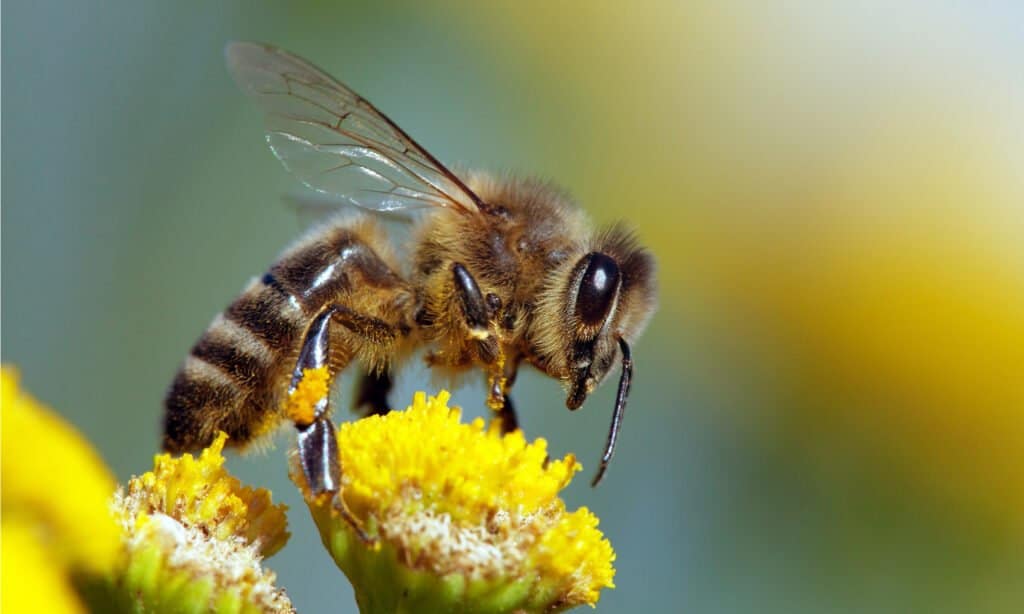
Honeybees typically live in hives or nests and communicate with one another through dance-like movements.
©Daniel Prudek/Shutterstock.com
Missouri’s state insect, the honeybee, was introduced on July 3, 1985. The honeybee is not a specific species but, rather, a group that encompasses all honey-producing bees. Honeybees typically live in hives or nests and communicate with one another through dance-like movements. Honeybees inhabit a variety of places, including Asia and Europe. The domestic honeybee or the western honeybee lives in the United States. Its scientific name is Apis mallifera.
Aquatic Animal: Paddlefish
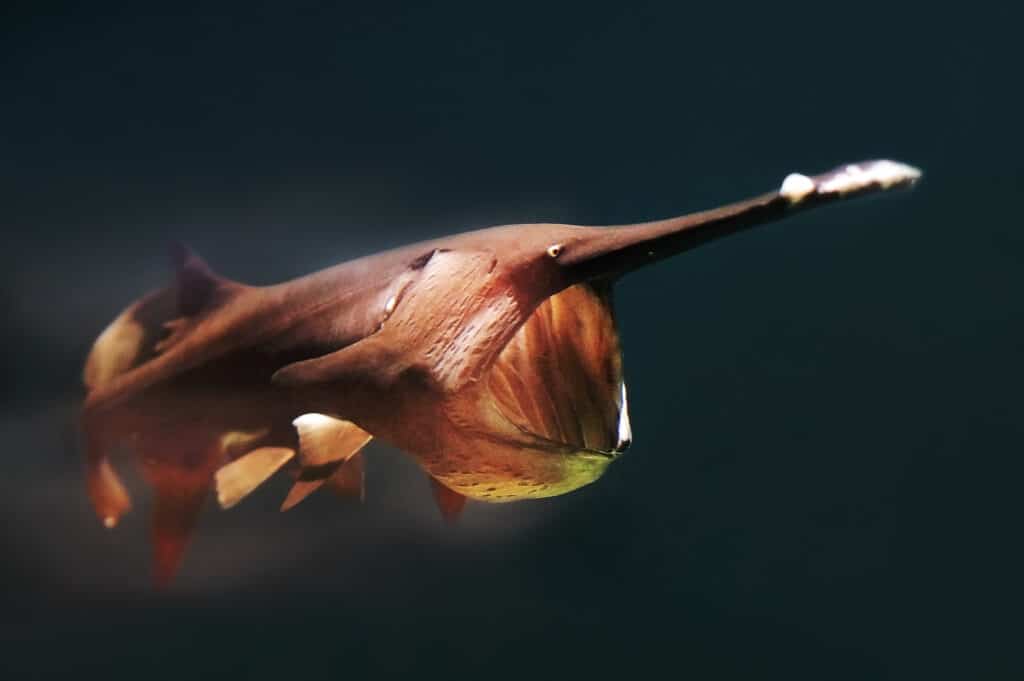
The American paddlefish has a green and gray coloration and weighs an average of 40 pounds.
©Marina Veder/Shutterstock.com
The paddlefish was introduced on May 23, 1997, as Missouri’s state aquatic animal. Three rivers in Missouri in which the paddlefish is most prevalent include the Mississippi River, the Missouri River, and the Osage River. Paddlefish are freshwater fish with a nose that extends outward and looks like a paddle. The term paddlefish describes not one species but a family of species. The American paddlefish has a green and gray coloration. It weighs an average of 40 pounds and measures up to 7.2 feet in length. However, some paddlefish have weighed a maximum of 200 pounds! These fish are primarily native to the Mississippi River basin and to several areas in Missouri and in the Midwest.
Fish: Channel Catfish

This species is the most prominent large
catfish
in the state.
©Aleron Val/Shutterstock.com
The state fish of Missouri is the channel catfish, which was introduced on May 23, 1997. Channel catfish measure between 22 and 52 inches in length, but those native to Missouri are typically smaller, between 12 and 32 inches. They weigh approximately 15 pounds. Like the paddlefish, channel catfish have a greenish-gray coloration. Mating season for the channel catfish typically occurs during spring and summer, between the months of April and July. Channel catfish are omnivores, meaning they consume animals and plants alike. This species is the most prominent large catfish in the state.
Horse: Missouri Fox Trotter

The horse is a staple of the state, and several organizations have paid homage to the breed.
©Gaitedhorse / CC BY-SA 4.0 – License
Missouri introduced the Missouri Fox Trotter as the state horse on June 4, 2002. The horse breed derives from the Ozark hills within the state, where it was developed nearly two centuries prior. The Missouri Fox Trotter is a gaited horse, meaning that it trots with its hind feet and walks with its front feet. This action ensures a smooth and enjoyable ride. The horse is a staple of the state, and several organizations have paid homage to the breed, such as the Missouri Fox Trotting Horse Breed Association.
Dinosaur: Parrosaurus Missouriense
That’s right, Missouri has its very own state dinosaur, which was introduced on July 9, 2004. The Parrosaurus missouriense is a type of Hadrosaur, meaning it has a bill shaped like that of a duck. Dan Stewart discovered this dinosaur’s remains in 1942. It is likely that it resided in the state during the Late Cretaceous Period. It had over 1,000 individual teeth, though it was an herbivore. Vegetation during this period was thick and dense, so thousands of sharp teeth were necessary to receive adequate sustenance. The dinosaur most likely weighed over three tons and stood a whopping 10 feet tall.
Amphibian: American Bullfrog

The American bullfrog’s coloration ranges from green to brown, with dark brown speckles.
The American bullfrog was introduced as Missouri’s state amphibian on June 5, 2005. The frog permeates every region of the state, and it is the largest frog indigenous to Missouri. The American bullfrog’s coloration ranges from green to brown, with dark brown speckles. Females can lay up to 20,000 eggs during mating season. The habitat of the American bullfrog includes the shallow waters of ponds, lakes, streams, and rivers. These creatures are of medium size, weighing up to one pound and having a maximum measurement of 8 inches.
Game Bird: Bobwhite Quail

Feathers of the bobwhite quail have an ornate arrangement of brown, white, black, and a rust-like color. Their heads have black and white stripes.
©iStock.com/twildlife
Missouri’s state game bird has been the bobwhite quail since July 13, 2007. Feathers of the bobwhite quail include an ornate arrangement of brown, white, black, and a rust-like color. Their heads have black and white stripes. Habitats of this game bird include forests and open areas such as grasslands and fields. During the seasons of autumn and winter, bobwhite quail travel and reside in groups called coveys. The size of a covey ranges from 10 to 30 birds. Mating season occurs during spring and summer when males utilize the bobwhite whistle to attract a mate.
Invertebrate: Crayfish
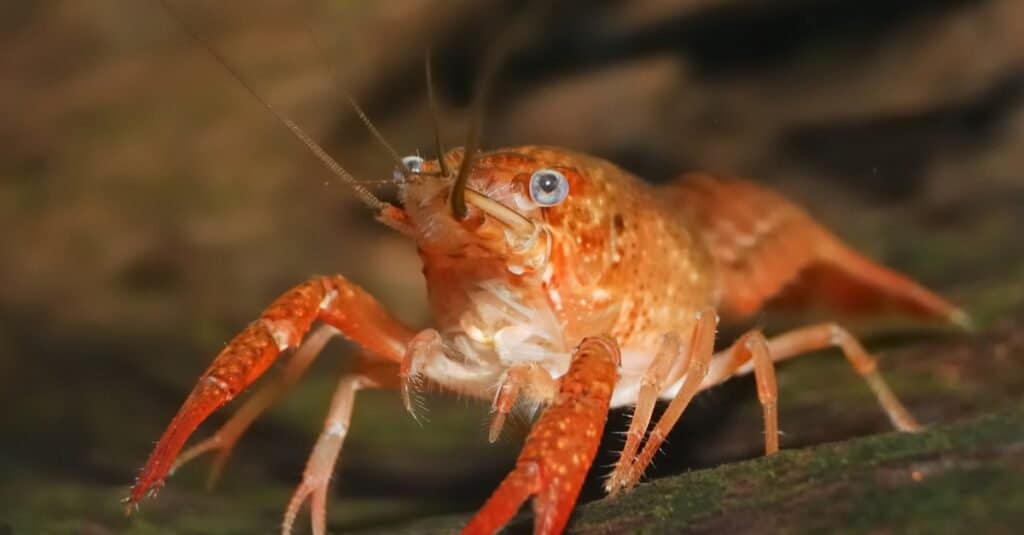
Crayfish come in a variety of sizes and their coloration can be green, red, brown, or a muted yellow.
©Alex Stemmers/Shutterstock.com
The state invertebrate is the crayfish, also called crawfish or crawdads. Introduced on June 21, 2007, the crayfish represents Missouri’s unique biodiversity. In fact, of the 30 species of crayfish in Missouri’s bodies of water, seven of them live only in this state. These creatures primarily reside in freshwater environments, but some live in saltwater or in brackish water. Crayfish come in a variety of sizes, from as little as 0.98 inches up to 15.75 inches. Their coloration can be green, red, brown, or a muted yellow.
Reptile: Three-Toed Box Turtle
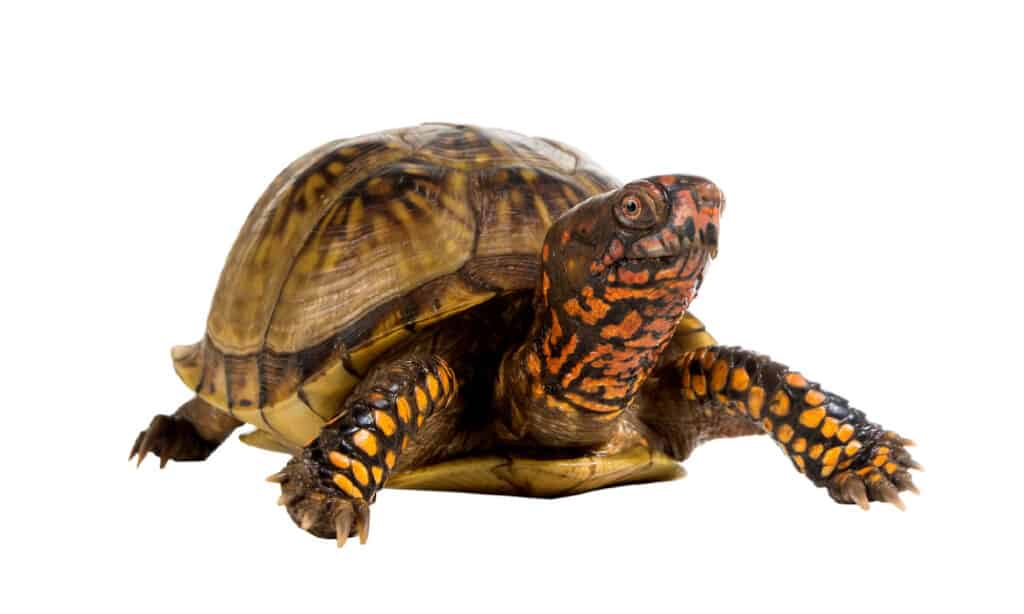
Their common name derives from their hind legs, which typically have three toes.
©iStock.com/irin717
On June 21, 2007, the state introduced the three-toed box turtle as Missouri’s reptile. These turtles live on land, and their shells are typically olive green or brown. Their common name derives from their hind legs, which typically have three toes. The three-toed box turtle inhabits central and southern Missouri. In northern Missouri, their populations are smaller. The habitat of the three-toed box turtle includes woodlands and grasslands. For food, these animals look for a variety of plants, fruits, and fungi, along with invertebrates and insects.
Historical Dog: Old Drum

©Abernaki / Public Domain – License
Missouri introduced its historical dog on August 28, 2017. Back in 1869, a hunting dog named Old Drum grew to national prominence. Tragically, the dog was shot and killed, and its owner sued the shooter for $100. The case made its way to the Missouri Supreme Court, where prosecutors read the famous Eulogy of the Dog aloud in the courtroom. The speech and Old Drum’s death were so touching that the state erected a statue of Old Drum outside the Johnson County courthouse. On the statue lies a plaque that features the written script of Eulogy of the Dog.
Wonder Dog: Jim

Jim the Wonder Dog Memorial Garden on the square in Marshall, Missouri.
©Americasroof / CC BY-SA 3.0 – License
Missouri’s wonder dog was a Llewellyn Setter known as “Jim the Wonder Dog.” He was inducted into the state animals “club” on the same day as Old Drum. Jim was born in 1925, and he became famous for his impeccable hunting skills. Jim tracked more than 5,000 birds, and his talent gained him a feature in Outdoor Life Magazine. This extremely intelligent dog could do more than hunt birds, though. He could recognize license plates, written instructions, and singular faces in a crowd of people! After his death, his owner buried him in Ridge Park Cemetery in Marshall, Missouri.
Endangered Species: Hellbender Salamander
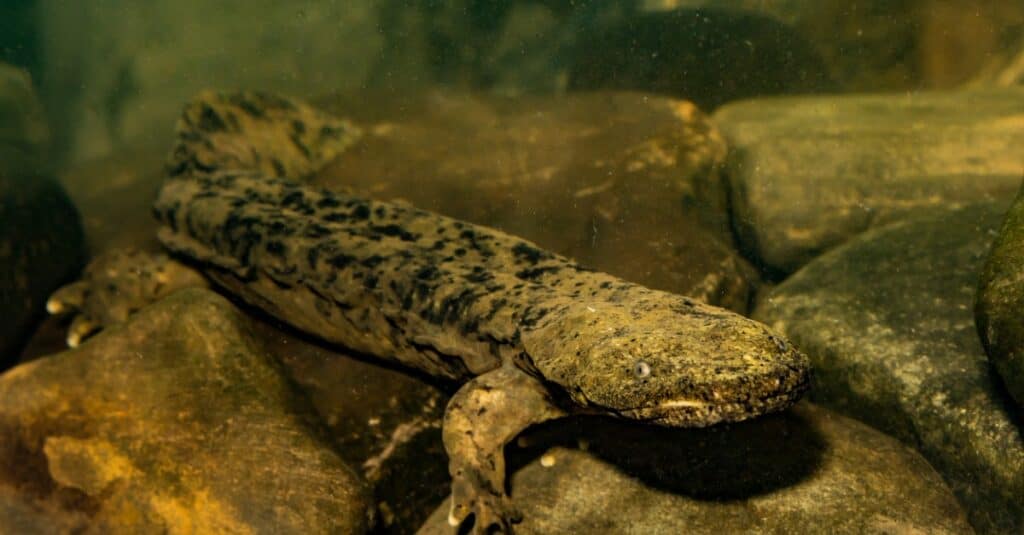
Other names for the hellbender
salamander
include the “snot otter” and the “lasagna lizard.”
©Jay Ondreicka/Shutterstock.com
Introduced on August 28, 2019, the hellbender salamander was named Missouri’s official endangered species. Other names for the hellbender salamander include the “snot otter” and the “lasagna lizard.” Subspecies of the animal include the eastern hellbender and the Ozark hellbender. They have a maximum length of 2 feet and a maximum lifespan of 30 years. This animal is unique to Missouri in that both subspecies only exist in this state. Conservation efforts have been made to protect the hellbender salamander, and many have proved successful.
State Animal: Missouri Mule

For many Missouri residents, the animal represents heritage and persistence.
©slowmotiongli/Shutterstock.com
Last but certainly not least, the Missouri mule has held the title of Missouri’s state animal since May 31, 1995. When the Missouri mule first came to the state in the early 1800s, it was used for agricultural purposes and as a draft mule. Many settlers saw value in the mule because of its strength and endurance. Long journeys west required help from the Missouri mule, and it aided the military during the World Wars by carrying necessary supplies. For many Missouri residents, the animal represents heritage and persistence.
Other Missouri State Symbols
Aside from the wide variety of state animals within Missouri, other natural symbols exist. These include trees, flowers, and fruit. Below are additional natural symbols within the state of Missouri:
- The State Floral Emblem: white hawthorn blossom
- The State Tree: flowering dogwood
- The State Mineral: Galena
- The State Rock: Mozarkite
- The State Fossil: crinoid
- The State Tree Nut: eastern black walnut
- The State Grape: Norton/Cynthiana grape
- The State Grass: big bluestem
- The State Fruit Tree: Pawpaw tree
Honorable Mention: Rally Squirrel
While “rally squirrel” isn’t a real species or an official state symbol, it has become one of the most infamous animals among the state’s residents, especially among fans of the St. Louis Cardinals baseball team. In 2011, a gray squirrel ran across the home plate during a Philadelphia Phillies-versus-St. Louis Cardinals game. After its dramatic entrance and rapid exit, people went nuts over the squirrel.
The St. Louis Cardinals eventually won the 2011 World Series, and many attributed the win to the squirrel, which they dubbed “rally squirrel.” Fans and players saw the squirrel as a sign of good fortune for the Cardinals. Now, the squirrel acts as a sort of a second mascot to the baseball champs. The animal signifies victory, sportsmanship, and teamwork for many Missourians. The Cardinals even sold rally squirrel merchandise!
The photo featured at the top of this post is © iStock.com/187715314
FAQs (Frequently Asked Questions)
What is the official state animal of Missouri?
The official state animal of Missouri is the Missouri mule, which represents a cultural significance and heritage for many residents of the state.
What other state symbols exist for Missouri?
Other state symbols of Missouri include the flowering dogwood tree, the eastern black walnut, the white hawthorn blossom, the crinoid fossil, and more.
What animal groups are included in Missouri's state symbols?
Missouri includes all the primary animal groups in its state symbols: mammals, amphibians, fish, insects, reptiles, and birds.
Thank you for reading! Have some feedback for us? Contact the AZ Animals editorial team.






